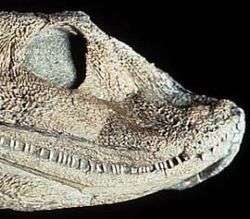Study of jaw mechanics shows tetrapods still fed underwater

A study of the jaws of one of the earliest known limbed vertebrates shows the species still fed underwater, not on land.
Scientists from the University of Lincoln, UK, University of Zurich, Switzerland, University of Cambridge and University of Bristol, developed an innovative new method to infer the feeding mechanism of Acanthostega – one of the earliest and most primitive tetrapods.
Tetrapods - the four-legged limbed vertebrates - evolved from fish and include today's amphibians, reptiles, birds and mammals.
Acanthostega is regarded as one of the best known early tetrapods, and has played a key role in debates about tetrapod origins since spectacular new specimens were discovered in Greenland in 1987. Dating back to some 360 million years ago (end of the Devonian period); it has often been seen as a near-perfect fish-tetrapod intermediate.
The UK and Swiss researchers employed advanced statistical methods from a range of disciplines to explore the anatomical, functional and ecological changes associated with the emergence of tetrapods.
They examined the movement and structure of the lower jaws of Acanthostega and several other early tetrapods and tetrapod-like fish. Their observations suggest the Acanthostega jaw was more geared towards feeding under water, indicating that this tetrapod retained a primarily aquatic lifestyle.
Dr Marcello Ruta, from the University of Lincoln's School of Life Sciences, said: "The origin of tetrapod from fish is an iconic example of a major evolutionary transition. The fossils of Acanthostega continue to play an unsurpassed role in our understanding of the fish-tetrapod transition.
"Acanthostega retained many primitive and fish-like features while also displaying unquestionable tetrapod features such as fingers and toes. Its broad snout appears to be consistent with aquatic feeding habits (suction feeding), but its complex cranial joints appear to be similar to those of terrestrial vertebrates and would suggest direct biting on land environments as a means of prey capture. This paradox prompted our study."
The team examined patterns of jaw shape variation to assess whether the Acanthostega jaw is overall more similar to the jaws of fish or those of tetrapods. They then used advanced engineering methods to simulate biting action.
Dr Ruta said: "The lower jaw of Acanthostega can be shown to be anatomically and functionally similar to the jaws of some early fish and contemporary fish-tetrapod intermediates.
"Its upturned anterior extremity and rearward-facing anterior fangs appear to be adaptations for a snapping action. All these observations imply that this type of jaw was capable of fast closure for efficient capture of fast prey, in support of a predominantly if not exclusively aquatic feeding action."
More information:
Neenan JM, Ruta M, Clack JA, Rayfield EJ. 2014. "Feeding biomechanics in Acanthostega and across the fish–tetrapod transition." Proc. R. Soc. B 20132689.
DOI: 10.1098/rspb.2013.2689
Provided by University of Lincoln




















